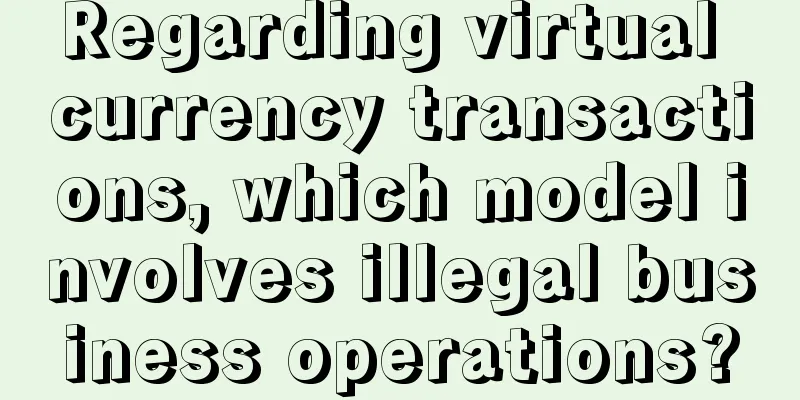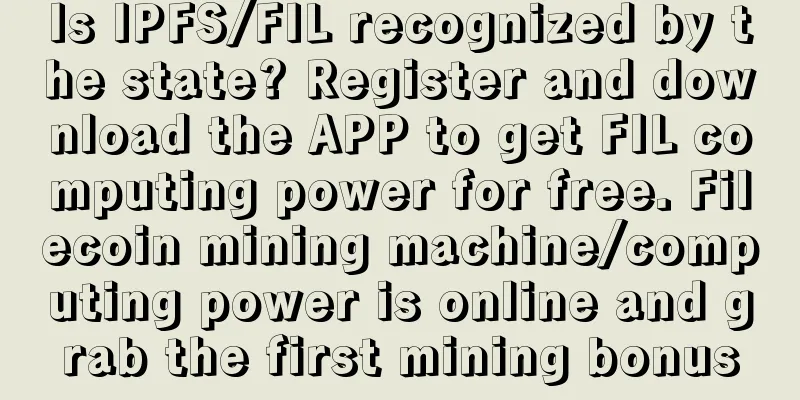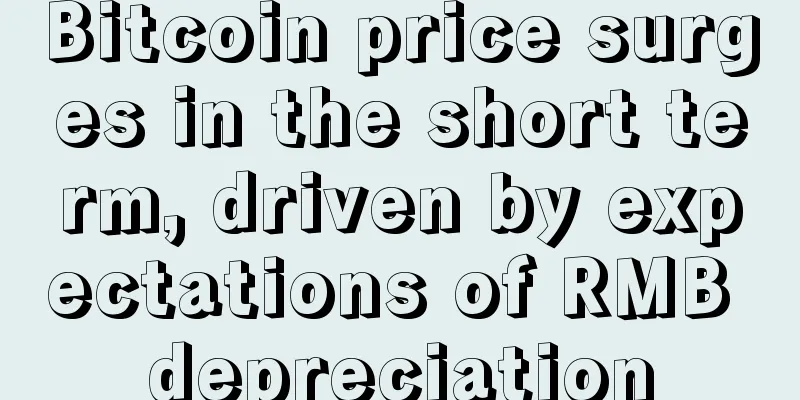Prospects for the application of blockchain technology in the field of electronic invoices

|
This article combines the current status of the promotion and application of electronic invoices and some of the difficulties encountered, analyzes the methods and advantages of using blockchain technology to solve these difficulties, and looks forward to the assistance and related application scenarios that blockchain technology can provide in the subsequent comprehensive and in-depth application of electronic invoices among enterprises. Current status of electronic invoice application(1) Policy status The State Administration of Taxation issued an announcement at the end of 2015, announcing that the issuance of VAT electronic ordinary invoices through the VAT electronic invoice system will be implemented nationwide from January 1, 2016, and other electronic invoice issuance systems will be discontinued at the same time. This policy and the launch of the corresponding VAT electronic invoice system mainly solve the invoicing problems of some industries with large invoice issuance volumes after the business tax reform. These industries have a large number of invoicing businesses for individuals, such as e-commerce, telecommunications, express delivery, and public utilities. (For more information, please refer to: http://www.chinatax.gov.cn/n810341/n810765/n1465977/n1466007/c2061033/content.html ) The Ministry of Finance and the State Archives Administration announced the revised "Accounting Archives Management Measures" at the end of 2015, which came into effect on January 1, 2016. Article 8 stipulates that electronic accounting materials generated within the unit and subject to archiving can be stored only in electronic form to form electronic accounting archives. Article 9 stipulates that electronic accounting materials received from outside by the unit with electronic signatures in accordance with the provisions of the "Electronic Signature Law of the People's Republic of China" can be archived and stored only in electronic form to form electronic accounting archives. The revised "Accounting Archives Management Measures" solves the problem of direct entry of electronic invoices from a policy level. The VAT electronic ordinary invoices issued by the VAT electronic invoice system have the electronic signature of the tax digital certificate, which complies with the revised "Accounting Archives Management Measures" and can be archived and stored only in electronic form. (For more information, please refer to: http://www.mof.gov.cn/pub/tfs/zhengwuxinxi/caizhengbuling/201512/t20151214_1613338.html ) (2) Current status of electronic invoicing solutions At the end of 2015, the State Administration of Taxation released the policy of promoting electronic invoices and simultaneously released the technical plan of the VAT electronic invoice system as Appendix 2. The logical diagram of the VAT electronic invoice system implementation plan published in the plan is as follows: The number segment of the VAT electronic invoice is synchronized to the VAT electronic invoice system through the interface of the tax background collection and management system, and is finally assigned to the taxpayer through the VAT electronic invoice system. E-commerce and other enterprises with a large number of invoices can choose the server version of the tax control invoicing system to meet the large-scale centralized invoicing needs of the enterprise. Enterprises with a small number of invoices can use the stand-alone version of the tax control invoicing system to complete the issuance of electronic invoices and the generation of electronic data. The electronic invoice format file can be generated directly on the enterprise side or by a third-party electronic invoice service platform. Taxpayers who use a third-party electronic invoice service platform need to pass the electronic invoice data to the third-party electronic invoice service platform. The electronic invoice details are transmitted to the tax authorities in real time through the VAT electronic invoice system and enter the invoice electronic base account. There are two types of data interface specifications. The first type is applicable to taxpayers who issue electronic invoices using the tax control invoicing system (stand-alone version). The second type is applicable to taxpayers with a large number of invoices and using the tax control invoicing system (server version). (For more information, please refer to the website of the national implementation policy of the VAT electronic invoice system mentioned above). (3) Current status of enterprise electronic invoice management The following table describes the current status of electronic invoice management throughout its life cycle by comparing it with paper invoice management: The establishment of electronic accounting documents relies on the electronic signature law. The various digital certificate systems and archives involved in electronic invoices require a 30-year guarantee, which means that the electronic signatures and data can be verified to be available at any time within 30 years. Difficulties in the current application of electronic invoicesThe main difficulty in the current application of electronic invoices lies in the three aspects of enterprise management of electronic invoices, namely, reimbursement, accounting and preservation. The characteristics of electronic invoice files, such as their repeatable copying, repeatable submission and tampering, have brought new confusion to the reimbursement management, accounting management and archiving management of enterprises. Enterprises need to use professional information systems to implement reimbursement circulation, verify the authenticity of invoices and the integrity of invoice files, prevent the repeated accounting of invoices and keep the files intact and available for 30 years. In terms of solving the difficulties of enterprises managing electronic invoices, there are currently three types of service providers who are making efforts and have all been put online into the market. The first is the platform that provides electronic invoice issuance services, which has expanded and extended to the direction of reimbursement circulation, inspection, accounting, and preservation, becoming a complete electronic invoice solution platform; the second is traditional financial software service providers and tax accountant intermediary service agencies, which have built electronic invoice accounting and reimbursement management platforms; the third is the newly entered Internet enterprise service providers, such as WeChat's electronic invoice solution, which takes advantage of the communication platform to solve the pain points of invoice reimbursement circulation, and Alibaba's invoice service platform, which provides a complete electronic invoice solution platform. The following table summarizes and compares the advantages, disadvantages and limitations of various service provider platforms: The main difficulties in electronic invoice management are to solve the problems of duplicate reimbursement, reimbursement circulation and reliable preservation. Among them, the reimbursement circulation problem, for electronic invoices, if there is a well-constructed financial information system and platform support, electronic invoice reimbursement is more convenient and faster than paper invoices, otherwise it is more troublesome than paper invoices. At this stage, the solution to the problem of duplicate reimbursement mainly relies on a centralized unified service platform for identification, and the platform must be authoritative and credible. Reimbursement circulation is just a general information system optimization demand, which will become smoother and smoother with the investment of time. Reliable preservation is a bit special. Electronic invoice files basically enter a dormant state after 2 years. Whether to keep them online all the time is still a choice for the industry. Whether building a centralized service platform or adopting other technical solutions, the scale of data that needs to be processed by electronic invoice management is as follows: According to the China Taxation News, by the end of 2015, there were 5.92 million taxpayers in the pilot program for business tax to value-added tax nationwide, including 1.13 million general taxpayers and 4.79 million small-scale taxpayers. The number of taxpayers in the four new industries included in the pilot program is close to 10 million, which is 1.7 times the total number of taxpayers in the previous pilot program. (For more information, please refer to: http://www.ctaxnews.net.cn/html/2016-03/25/nw.D340100zgswb_20160325_2-08.htm) ) The above-mentioned number of business tax-to-VAT reform households is 16 million, plus the original number of VAT enterprises, it can be estimated that the total number is 20 million. The electronic invoice service platform needs to meet the needs of such a large number of enterprise applications. In terms of the number of invoices, according to a report by China Finance and Accounting Network on March 1, 2016, 60 million electronic invoices have been issued since the VAT electronic invoice system was implemented nationwide three months ago. (For more information, please refer to: http://www.e521.com/news/xyxw/450265.shtml ) Considering the trend of electronic invoices, the VAT paper invoices that are still in use should also be taken into account. The number of VAT paper special invoices issued in 2015 was more than 800 million. (For more information, please refer to: http://news.eastday.com/eastday/13news/auto/news/china/20160225/u7ai5337234.html ) The number of VAT general invoices is based on the information released by the State Administration of Taxation. On May 1, 2016, when the business tax-to-VAT reform was launched, a total of 23,669 pilot taxpayers issued 63,655 invoices, including 7,347 special VAT invoices and 56,308 general VAT invoices. (For more information, please refer to: http://www.chinatax.gov.cn/n810341/n810780/c2121786/content.html ) According to the above data, after the full electronicization of invoices, the number of invoices issued each year will be more than 10 billion. Main features of blockchain technology(1) Decentralization All applications of blockchain technology are based on the vast distributed nodes in the blockchain network, and do not require a centralized server platform, which opens up another way to save the construction cost of the electronic invoice service platform. Based on the calculation of 100GB storage space for each enterprise PC and 200KB for each electronic invoice, and 25% of 20 million enterprises, that is, 5 million PCs constitute the always-online nodes, the total network storage capacity is 500PB, which is converted into 2.5 trillion electronic invoices. If 10 billion copies are calculated each year, the invoice volume can be stored for 250 years, and more than 80 billion copies can be stored each year for 30 years. Not to mention the computing power, the computing power of more than 5 million nodes can meet the various applications in the field of electronic invoices without any problems. (2) Public ledger Blockchain technology uses a public ledger maintained by all nodes to solve the problem of duplicate payments. The problem of duplicate payments is very similar to the problem of duplicate reimbursement and duplicate entry of electronic invoices, or to put it more precisely, duplicate reimbursement and duplicate entry are essentially the same problem of duplicate payments. The public chain, private chain or a combination of the two involved in blockchain technology for solving the problem of duplicate payments can all be used to solve the problem of duplicate reimbursement and duplicate entry of electronic invoices. (3) Encryption algorithm Encryption algorithm is an essential supporting component of blockchain technology. Hash algorithm is widely used in blockchain to ensure the integrity of data blocks, and asymmetric algorithm is used to identify identity and encrypt and verify data. The VAT electronic invoice system has a complete digital certificate system and a good foundation for the application of encryption algorithm. There are no obstacles in the encryption algorithm when using blockchain technology in specific applications. (4) Distributed consensus Blockchain technology uses the opinions of the majority of nodes to form a consensus algorithm. Compared with the architecture of a centralized platform, the centralized platform needs to ensure its authority and reliability, which requires huge costs. Blockchain technology is guaranteed by the ledger and consensus algorithm jointly maintained by the majority of nodes. Compared with the centralized system, the cost is extremely low, almost free. (5) Flooding and efficiency issues Blockchain technology is prone to occupying network resources due to its distributed network broadcasting needs. The accumulation of public ledgers is prone to efficiency problems in later accounting. Electronic invoices only involve the issuer, the recipient and the tax bureau and are calculated on an annual basis. They are not interactive for all companies and are not prone to flooding and efficiency problems. A brief analysis of the basic points of blockchain technology for electronic invoice management(1) Relationship at the institutional level From the perspective of the accounting system, the VAT electronic invoice system promoted by the State Administration of Taxation has solved the problem of the generation of legal electronic original vouchers. The reimbursement and audit management functions provided by the industry financial system have solved the problem of the informatization of accounting vouchers. The two together constitute electronic accounting vouchers that can be recorded and archived. The revised "Accounting Archives Management Measures" has solved the problem of the formal recognition of electronic accounting vouchers as accounting vouchers. The above part is equivalent to solving the first half of the electronic invoice management. The problem in the second half is that in terms of recording and archiving, electronic vouchers are different from paper vouchers. They are not unique and immutable. There is a lack of authoritative electronic account books and electronic accounting voucher archivers. If it is stored in any database or any computer hard disk folder like manual operation, it can be said to make sense, but it is not feasible in actual business. This situation is a bit like the period when the national VAT system was introduced but the VAT anti-counterfeiting tax control system had not yet been implemented. Manual operation provided opportunities for the counterfeiting of VAT invoices because of the high cost of auditing. Ideally, the core modules for electronic voucher accounting and archiving in the financial systems of various service providers will be more effective if they are certified, published or planned in a unified standard by the Ministry of Finance and the National Accounting Association. This will fundamentally form a complete closed loop of electronic voucher accounting management, which is also the reason why there are differences in the current electronic invoice printing and paper invoice reimbursement and accounting processing. (2) The relationship between blockchain electronic invoice management and value-added tax electronic invoice system The current VAT electronic invoice system is part of the new invoice management system of the State Administration of Taxation. Based on the tax digital certificate and electronic account library, it provides complete VAT invoice issuance and information tax management functions. Even if combined with blockchain technology, the current new invoice management system is the best solution. Blockchain technology can contribute to electronic invoice management in that electronic invoices are the second half of the demand for electronic accounting documents, which is actually a connection, supplement and extension of the VAT electronic invoice system. (3) Blockchain node identity and composition The entire electronic invoice management blockchain network actually has two types of nodes, one is the enterprise node, and the other is the tax bureau nodes at all levels. The enterprise node uses the enterprise tax number and the tax digital certificate public key as the node identity, and the tax bureau node uses its unit name or number and the tax digital certificate public key as the node identity. For any enterprise node PC, in addition to installing the VAT invoice issuance system, a blockchain client program is also installed. It is called a client program because it is a distributed network, so the program is actually two parts, the server and the client. The server part serves the business stakeholders and the competent tax bureau’s access, and the client part handles local business. (4) Principles for setting up the ledger (chain) For the management of electronic invoices, it is meaningless and unfeasible to establish a nationwide unified public ledger chain. For any electronic invoice, it is only related to its issuer, recipient and the local tax bureau. The establishment of each ledger only needs to be set up by its relevant parties. In other words, the blockchain of electronic invoices is actually a group of blockchains that have a pointing relationship but no link relationship with each other. For the initial number segment allocation of electronic invoices, an electronic invoice number segment allocation ledger is established based on the provincial bureau. Only the provincial tax bureau node has the authority to write the invoice number segment allocation, which is equivalent to the provincial tax bureau paying a blank electronic invoice that can be issued to the enterprise. Each receiving enterprise writes the receiving block according to the number segment, and the receiving enterprise can only save the number segment block related to itself. For the accounting of electronic invoices of enterprises, you can establish your own sales invoice chain and input invoice chain. After the invoice recipient obtains the electronic invoice, he can access the node of the invoice issuer for verification, or directly use the public key of the invoice issuer for verification. After the verification is passed, it is written into its own accounting chain, and the accounting block is also written into the corresponding block of the invoice issuer's sales account book. In this way, any sales invoice block of any enterprise can only have one legal accounting block. If there are more than one, the consensus mechanism of business stakeholders can be enabled for judgment, thereby solving the problem of duplicate accounting. When an enterprise saves electronic invoices, it only saves business stakeholders, and additional off-site backup can be considered. Select some nodes with a large distance span, such as A, B, C, D, and E five companies do business with each other, then company B saves the account books of ABC and ignores the others, and company C saves the account books of BCD and ignores the others. In this way, the rational use of overall network resources and node computer resources is achieved, and the blockchain groups built by various business stakeholders intersect with each other, and the stakeholders have a public account book and consensus mechanism. Generally, the blockchain ledgers of all enterprises in the country do not need to be traversed. In extreme cases, if the electronic base account library is damaged, the tax bureau node can initiate a traversal to string together the ledger chains of all enterprises and restore the electronic base account library. Of course, under normal circumstances, enterprise nodes do not have such authority and the authority to access other node ledgers that are not related to the business. For large enterprises, they generally have their own data centers. If they wish, they can also use the resources of the blockchain network to run the ledgers. In this way, a mechanism can be designed in which large enterprises pay resource usage fees and small enterprises benefit, similar to the reward of Bitcoin's proof-of-work mining mechanism. A brief analysis of blockchain creating vertical solutions for industry electronic invoices and integrating into the Belt and Road InitiativeOn October 14, 2016, China Supply and Marketing Group and China National Textile Industry Enterprise Management Association jointly launched an initiative in Nantong, Jiangsu to establish the Belt and Road Textile Trading Alliance, planning to use the latest blockchain and smart contracts to establish a textile trading credit system for the Belt and Road. The Belt and Road Textile Trading Alliance has opened up all links in the textile industry, including cotton mills, traders, raw material suppliers, financial institutions, associations, and Chinese and foreign textile companies on the Belt and Road. (For more information, please refer to: http://ytcj.baijia.baidu.com/article/657324 ) The current main research hotspot of blockchain applications is financial settlement, especially cross-border settlement, with the aim of reducing the cost of cross-border settlement. Compared with the docking of centralized systems, blockchain technology has lower costs and higher efficiency in cross-border settlement. At present, domestic electronic invoices for tax declaration and export tax rebates are basically two information system groups, similar to the textile alliance mentioned above. In food and drug traceability and supply chain management, or other industries of the Belt and Road Initiative, commercial transactions are related to electronic invoices. Blockchain electronic invoice management solutions are conducive to creating industry vertical solutions and integrating into the information system support of the Belt and Road Initiative. Food and drug traceability and related electronic contracts and smart contracts themselves are the basic advantages of blockchain technology. ConclusionBlockchain technology is not a panacea. It is a new combined application mechanism that emerged after the mature application of network technology, encryption technology, and distributed technology. In the field of electronic invoices, blockchain technology can serve as an effective supplement to the centralized system, solve technical and business problems, and reduce overall costs. This article does not provide a more detailed explanation of blockchain technology itself and electronic invoices itself, so if readers are interested, they need to learn more about the relevant knowledge. The explanations in this article only represent personal opinions for technical discussion and communication. Readers are welcome to give feedback. The author will also publish subsequent articles on related topics. Readers are welcome to correct me. |
<<: What is the debate between soft expansion and hard expansion all about?
Recommend
Analysis: What kind of face has good fortune in wealth?
In traditional Chinese culture, wealth is divided...
Face reading: Men with broken palm lines never give up
1. Independence A man with a broken palm line has...
Which facial features make people most capable of making money?
Which facial features make people most capable of...
What are the characteristics of a person with a lot of emotional distress?
Emotional difficulties are something that many pe...
Looking at the infinite possibilities of the industry in the future from the innovation of Shenma press conference
On April 17, the online launch of the new product...
Revealing the secrets of widowhood: marriages are doomed to be unhappy
For a woman, her husband is her support and the s...
What is the personality fortune of men with phoenix eyes?
There is an old saying that goes, "Appearanc...
Snapchat's first investor: Bitcoin price will reach $500,000 by 2030
Rage Comment : Jeremy Liew, the first investor of...
What does a nose with good fortune look like?
What does a nose with good fortune look like? Peo...
Can good moles and bad moles be distinguished by their shapes?
I believe everyone has known that there are good m...
What is the meaning of short eyebrows?
Eyebrows can show a person's mental outlook. ...
What does a dog's nose look like?
Dog nose: A dog nose is a sign of high longevity,...
Is there still hope for an Ethereum spot ETF? What risks is the SEC blocking?
In early March, the US SEC postponed its decision...
What is the fortune of people without a fortune line? Interpretation of fortunes of different fortune lines
The wealth line is a key point that is often menti...
Barbarians outside the election gate: Crypto whales quietly eroding the US political arena
On July 23, according to the FEC official website...









